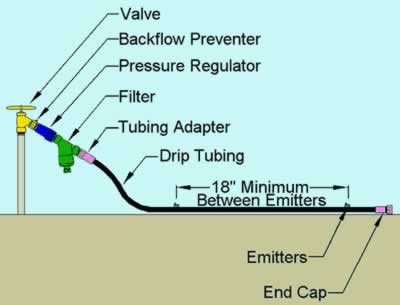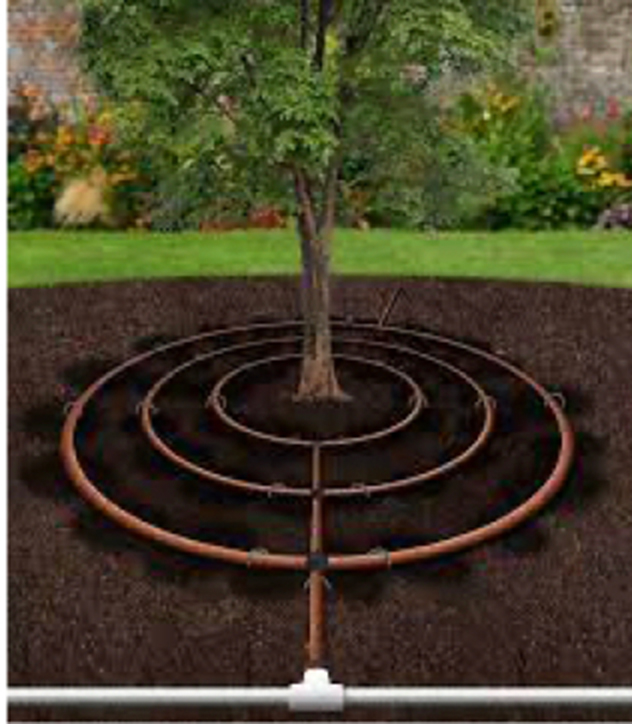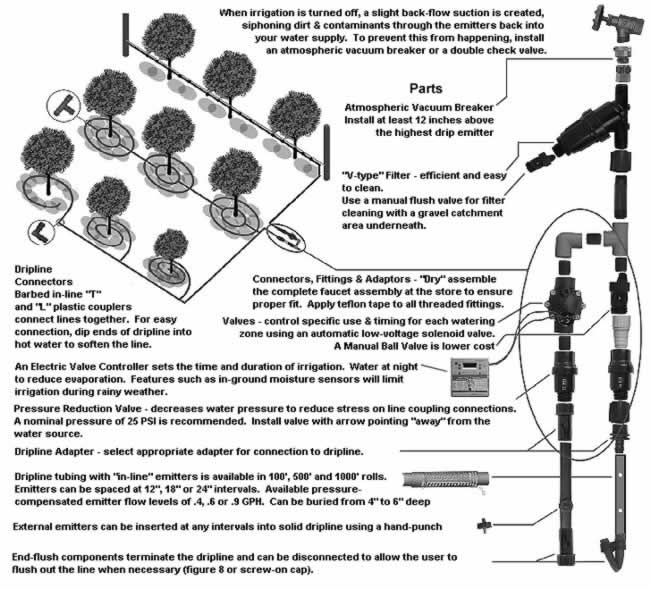Drip Systems
Low flow irrigation (also known as micro irrigation) refers to emitters, drip lines, micro sprays, and mini rotors.
Drip irrigation systems (also known as micro, low-flow, low-volume, and trickle) use drip emitters, inline emitters, miniature sprayers, and micro-sprays.
Micro spray and mini rotors clog easily and need frequent maintenance. Observe monthly and make any necessary repairs or replacements to emitters.
Drip lines are recommended for continuously rooting ground covers such as Roman chamomile (see Plants on Main Menu).
Drip lines are flexible tubing with emitters (tiny water-flow regulators in each hole in the line) evenly spaced along the tubing. Drip lines are also called inline drip or subsurface drip. Some drip lines may be placed on top of the ground with an emitter(s) at each plant and covered by a few inches of mulch. A subsurface drip line (underground) can be used to irrigate ground covers. Installation can occur before (in ground) or after (above ground) for groundcovers.
For individual emitter layouts, water is delivered just where plants need it. This can reduce the area for, and number of, weeds in the garden.
Water is applied very slowly in gallons per hour (gph).
Inline drip must operate at a reduced pressure in order to deliver only a small amount of water at a specified rate and, therefore, requires a pressure regulator and filter for each irrigation valve using drip lines. It is recommended to use a 30 psi pressure regulator and 200 mesh filter.
Drip systems can be connected to a hose end and manually operated, or permanently connected to your main water source and operated by an automatic controller.
Plan enough capacity (emitters) to deliver the needed amount of water as your landscape matures. Use the product’s emitter selection chart to determine the flow rate and number of emitters per plant.
For areas with long runs of tubing and changes in grade, pressure compensating emitters should be used.

Drip for Trees
To provide trees with adequate water to the rootzone and to promote growth, lay out the tubing in rings spaced out from the tree trunk.
 Example of a tree ring layout
Example of a tree ring layout
Tips for using drip irrigation in your garden
Use a timer to automate your drip irrigation system. This will save you time and energy and help you to avoid over-watering or under-watering your plants. Plants require less irrigation during the rainy season and may need supplemental watering during the summer. A weather-based irrigation controller can automatically adjust the watering schedule for you. Rebates are available for eligible smart timer models.
Regularly check for any breaks or leaks in your system. Replace leaking or clogged emitters regularly. This will help you to avoid wasting water and keep your plants watered properly. Look and listen for geysers, spouts, leaks, puddling, and pooling. Listen for hissing or high-pitched squealing sounds that may indicate that you need an air/vacuum relief valve or a new pressure regulator.
Have extra emitter tubing and connectors on hand for quick fixes. All materials used for repairs should be the same brand as your original equipment.
Cover drip tubing with mulch. This will reduce evaporation and help the soil to retain moisture. It also protects tubing from turning brittle due to sun exposure.
Check and clean filters seasonally. Filters should be replaced if damaged.
Uncap the main lines and run each system for a few minutes to remove any build-up in your system.
Areas of concern when using drip:
Polyethylene ("poly") tubing on the surface in areas of heavy foot traffic or children's play areas can easily be broken, disconnected, vandalized, or present a tripping hazard.
Dogs, raccoons, gophers, and other animals may chew tubing and emitters.
If a pre-packaged drip kit is used, be sure the components are of high quality and right for the job. Keep the manufacturer’s contact information so replacement parts can be located.
